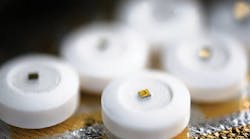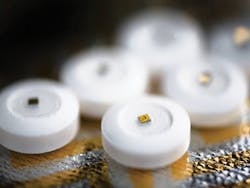Drug-delivery methods have achieved science fiction status following news of two breakthroughs: A wirelessly controlled contraceptive chip that can be implanted in women, and pills that are able to text medical professionals and caregivers that patients have taken their medicine. Whereas this may sound like a storyline from an episode of “Star Trek,” what we are talking about are here-and-now realities.
So, what about these pills that can send texts? Who needs them? According to the U.S. Department of Health and Human Services, five out of six Americans aged 65 and older are taking at least one medication daily, and almost half of the elderly take three or more. It is to this latter group that texting medication could prove invaluable. Elderly patients can forget to take their medicine, and a pill that texts caregivers or medical professionals that the medication is being ingested could save lives.
This file type includes high resolution graphics and schematics when applicable.
How is the text sent? Enter Proteus. No, not the sea god from Greek mythology or the microscopic submarine in the film "Fantastic Voyage." This is a tiny sensor that can be embedded into medicine tablets and then swallowed. Developed by digital medicine company Proteus Digital Health (see figure), the sensor is activated and powered by the hydrochloric acid, potassium chloride, and sodium chloride that form stomach acid.
Proteus works on the basis that when certain dissimilar elements are immersed or embedded in an ionic solution it creates power. What the developers have done with this sensor is taken two fundamental and required dietary elements—copper and magnesium—and embedded them in a tiny sensor that is less than 1 mm square.
After the pill is ingested, the stomach acid acts as the ionic fluid. This creates sufficient power for the sensor to link with and communicate to an adhesive patch worn by the patient.
It is this patch that communicates all of the patient’s data to a server, which can then be accessed by phone, tablet, or PC by medical professionals or designated members of the patient’s family. The data will include a description of the medicine taken, the dosage, and what batch it was issued from.
Importantly, the system also has the ability to analyze what effects the medicine is having or in some cases not having, whether it’s been prescribed at the right dosage, or if it simply isn’t working. This information can be crucial for people who have cardiac and diabetes-related conditions. Not only can it save lives, but it also significantly reduce health-care costs.
On-or-Off Contraceptive Chip
A computerized contraceptive chip implanted below a woman’s skin could be wirelessly activated or deactivated for up to 16 years. The chip, which is about the size of a thumbnail, releases a small dose of the hormone levonorgestrel—commonly used as an oral contraception.
The levonorgestrel is held within the device in minute compartments and kept in place by a thin platinum and titanium seal. The seal is melted by a small electrical charge, which releases a 30-microgram dose into the woman's body. This will happen automatically on a daily basis unless the chip is deactivated.
But while this on-off ability is very convenient, it does raise concerns about system security: Could somebody else turn the system off? Could it become a target for hacking pranksters?
Not surprisingly, the developers insist this could not happen. They say that secure algorithms and data encryption and the fact that communication has to be done at skin level would prevent inadvertent or pernicious interference.
A final question regarding this form of digital birth control focuses on just how reliable the device will be in mechanical terms. There are currently no studies that can emulate what 16 years of being housed in the human body might do to the chip. And let’s face it: 16 years equates to 5840 daily doses of levonorgestrel. That’s a lot of operations that have to consistently and accurately maintain 30-microgram doses.
This file type includes high resolution graphics and schematics when applicable.


